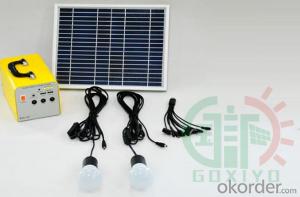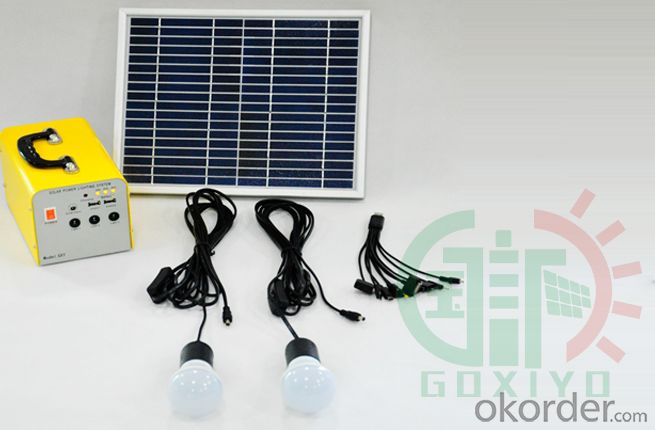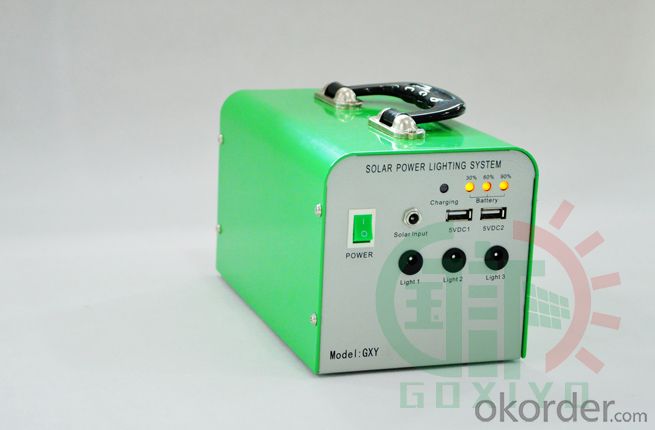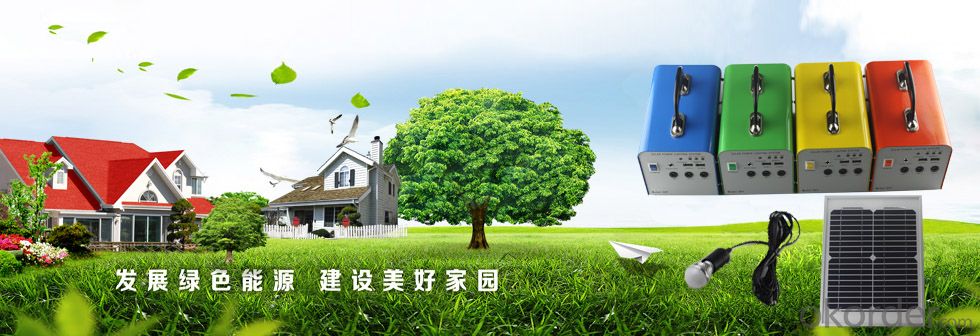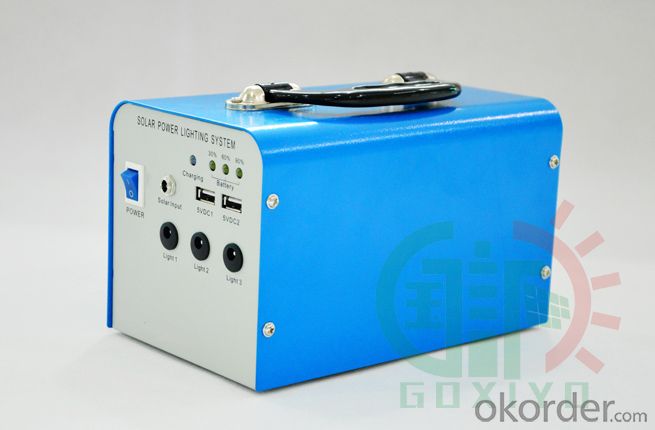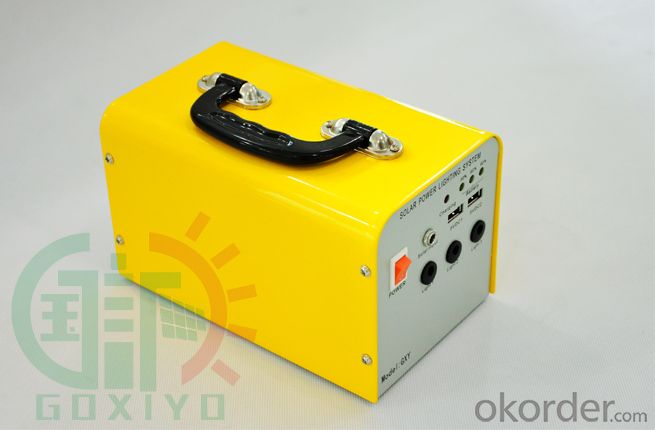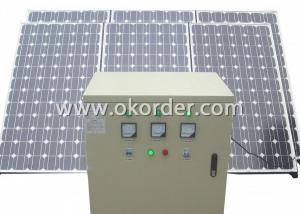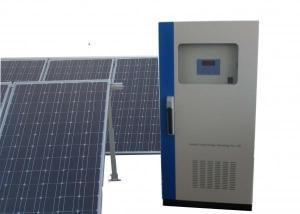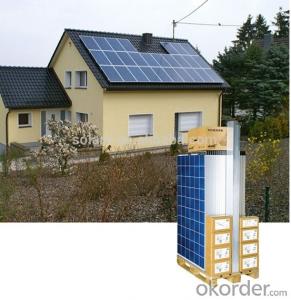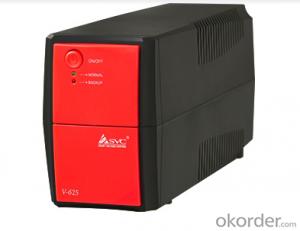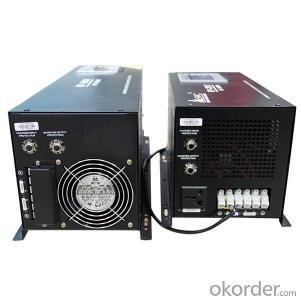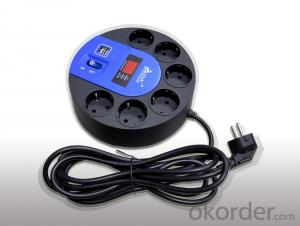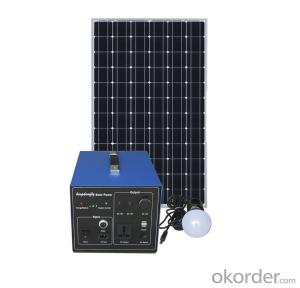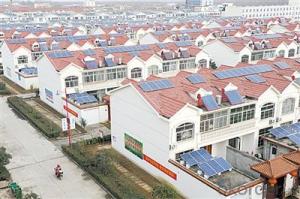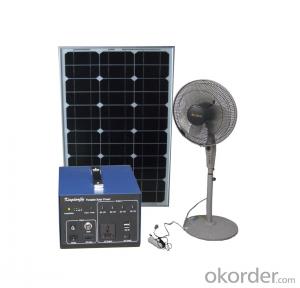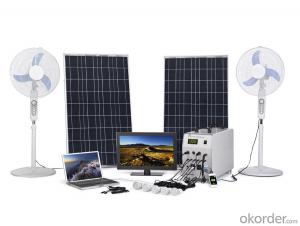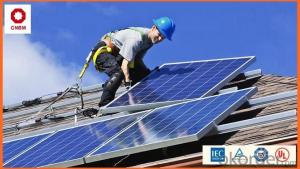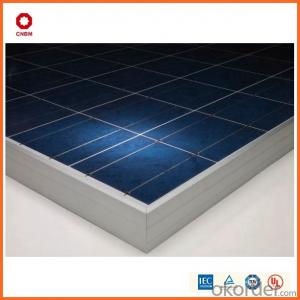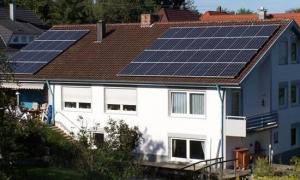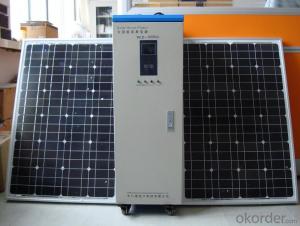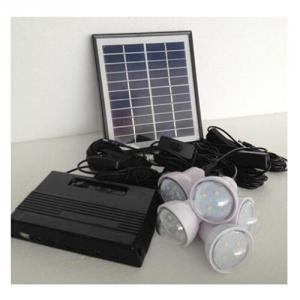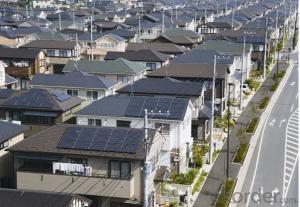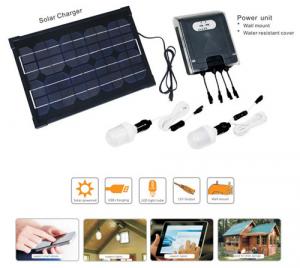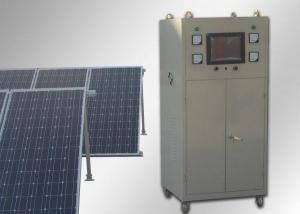Sharpe Solar Energy Systems 20W Solar Power Generation System Solar Charging System Solar Power Lighting
- Loading Port:
- Shekou
- Payment Terms:
- TT OR LC
- Min Order Qty:
- 1 set
- Supply Capability:
- 9999 set/month
OKorder Service Pledge
OKorder Financial Service
You Might Also Like
This solar power generation system design is exquisite, the body is very light, the battery and the solar energy special charge and discharge controller set in one, the use is convenient. System is widely used in home lighting, outdoor lighting, and with USB output port, you can give all kinds of mobile phones, MP3, cameras and other electronic digital products charge. The product is equipped with solar panels, especially for non electric lighting, but also the ideal lighting tool for camping.
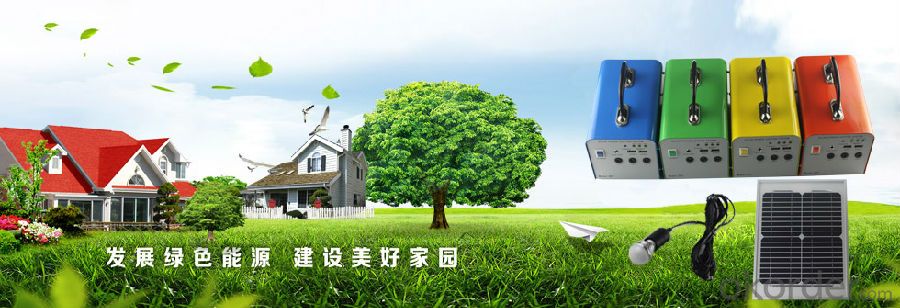
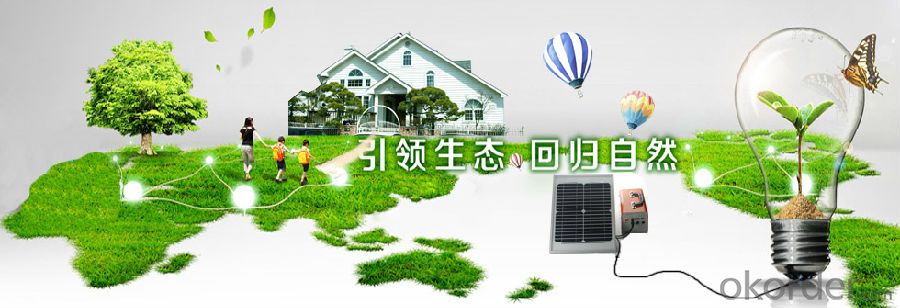
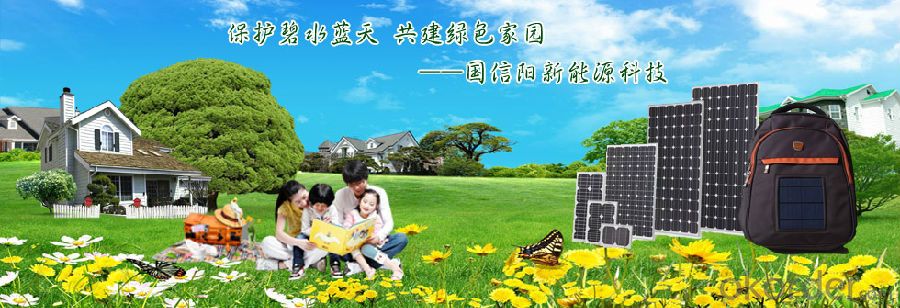
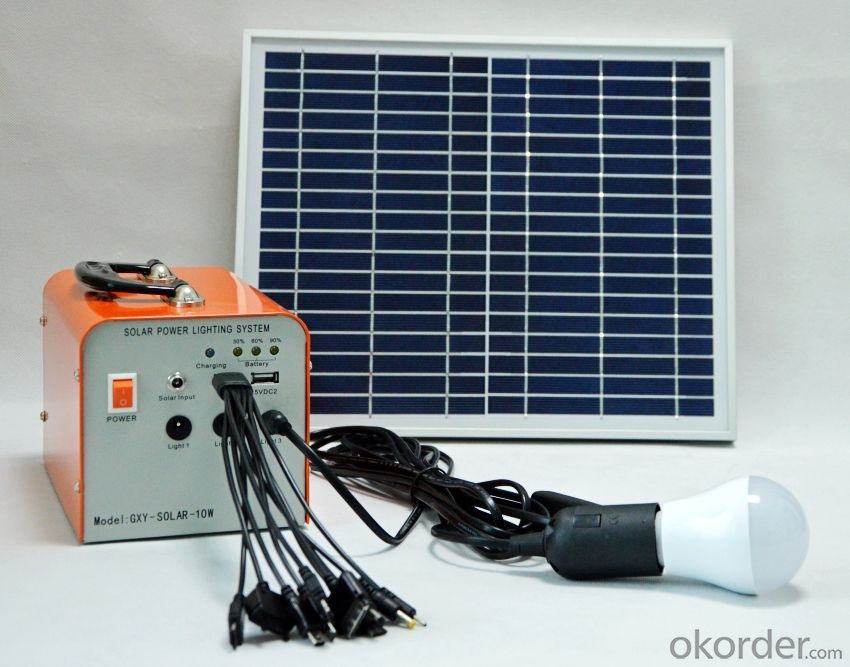
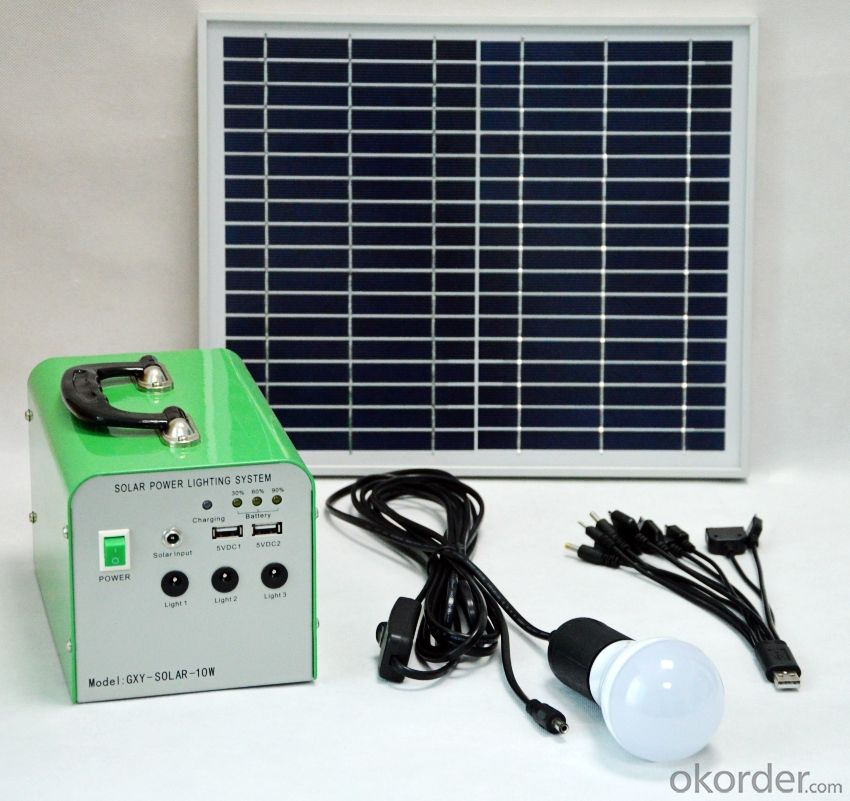
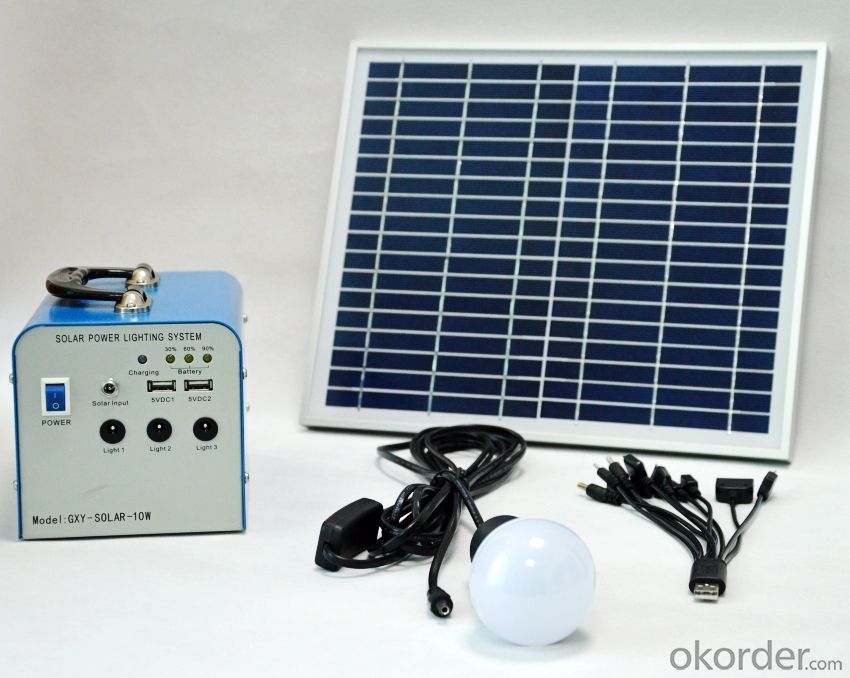
Quick Details | |||
Place of Origin: | Guangdong, China (Mainland) | Brand Name: | HYTN |
Model Number: | HYTN-SMP20 | Output Voltage (V): | 12 |
Specification: | Normal | Application: | Home |
Work Time (h): | 24-26 H | Load Power (W): | 3w |
Solar Power (W): | 20w | Work Time (h): | 24-26 H |
Name: | 20w grid solar system | Other name: | new style 10w grid solar system |
Solar Panel: | 20W 18V | Battery: | 9AH 12V |
USB Connector: | 5V 2000MA | DC output: | 12V 1500MA |
LED lamp: | 3w | DC Cable: | 5 meter DC cable, 5.5*2.1mm |
Charging time: | 5-7 H | Working time: | 24-26 H |
Packaging & Delivery | |||
Packaging Details: 20w grid solar system Packing: 395MM*187MM*170MM, Carton box 8.5KG | |||
Delivery Detail: 15 - 35 days | |||
Specifications | |||
20w grid solar system | |||
Product Description | |||
Specification of 20w grid solar system: | |||
Solar Panel | 20w, 18v, High efficiency polycrystalline solar panel, with 25 years working life time, framed with strong alluminum alloy, easy to carry around. | ||
Battery | 9AH,12V,Sealed maintenance-free lead-acid battery | ||
USB Connector | (5V,2000MA),2pcs, work with cell phone, MP3,MP4,MP5 etc | ||
DC output | (12V,1500MA),could drive 12DV fan or other DC devices. | ||
Shell | 1.0mm thickness iron box coated | ||
LED lamp | 3w high effiency energy saving LED bulb. | ||
Battery Display | LED display showing battery volume | ||
DC Cable | 5 meter DC cable, 5.5*2.1mm. Connecting solar panel with power bank and 5 meter cable, 5.5*2.5mm,connecting LED lights | ||
Mobile Charging Cable | Various most commonly used USB charging adaptors for you to charge all kinds of mobile phones | ||
Charging,Using Time | 5-7 hours charging time,24-26 hours working time with 3w LED | ||
Accessories | 1 power bank, 1 solar panel with 5 meter cable, 1 3w LED bulb with 5 meter cable, multi-adaptor USB cable, 1 copy of manual. | ||
Packaging | 395MM*187MM*170MM, 8.5KG | ||
Range | Camping,power back-up, hunting, fishing, Charging mobile phones, lighting home and other outdoor activities. | ||
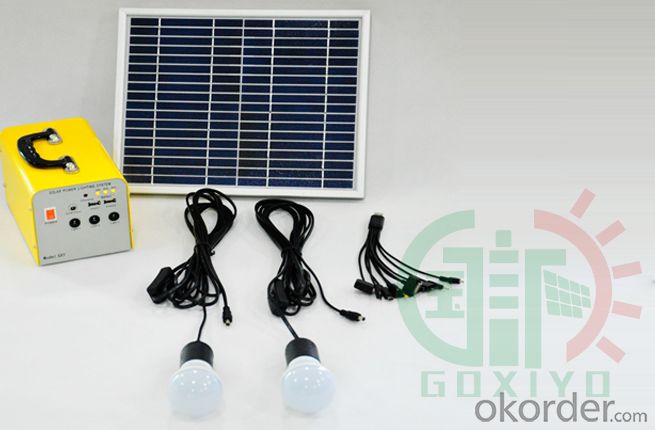
- Q: Are there any tax credits available for installing solar energy systems?
- Yes, there are tax credits available for installing solar energy systems. The federal government offers the Investment Tax Credit (ITC), which provides a credit of 26% of the total cost of the solar system installed. Some states also offer their own tax credits, incentives, or grants for solar installations. It is advisable to consult a tax professional or contact local authorities to determine the specific credits available in your area.
- Q: What is the difference between a solar tracker and a fixed-tilt solar energy system?
- A solar tracker is a system that follows the movement of the sun throughout the day, adjusting the position of solar panels to maximize sunlight exposure. On the other hand, a fixed-tilt solar energy system consists of solar panels that are mounted at a fixed angle, typically facing south, and do not move throughout the day. The main difference lies in their ability to track the sun's movement, resulting in increased energy production for solar trackers compared to fixed-tilt systems.
- Q: What is the expected return on investment for a solar energy system?
- The return on investment (ROI) for a solar energy system can vary based on several factors, such as the initial cost, location, available incentives, and energy usage. Typically, solar energy systems are expected to yield a positive ROI over their lifespan. Installing a solar energy system involves a significant upfront investment, including expenses for solar panels, inverters, and installation. However, the decreasing costs of solar technology in recent years have made the initial expense more affordable. The location of the solar energy system is crucial in determining the expected ROI. Areas with higher solar irradiance and longer sunshine hours tend to generate more electricity, resulting in a higher ROI. Additionally, net metering policies that allow excess electricity to be credited back to the owner can further boost the ROI. Government incentives and subsidies can have a significant impact on the expected ROI. Many countries provide tax credits, grants, and rebates to promote the adoption of solar energy systems. These incentives reduce the initial cost and expedite the payback period, thus enhancing the overall ROI. Furthermore, the energy usage of the property plays a critical role in determining the expected ROI. Higher electricity consumption offers more opportunities for the solar energy system to offset utility bills, resulting in greater savings and an improved ROI. While the specific ROI can vary, studies indicate that solar energy systems typically recoup their costs within 5 to 10 years and continue to generate free electricity for several decades. This extensive period of energy production allows for substantial savings on utility bills and a positive ROI over the system's lifetime. In summary, investing in a solar energy system can provide long-term financial benefits, including reduced electricity costs, potential revenue from excess electricity generation, and increased property value. Conducting a comprehensive evaluation considering the aforementioned factors is crucial in determining the expected ROI for a solar energy system in a specific scenario.
- Q: What are the advantages and disadvantages of small-scale solar power generation system?
- Solar power has no moving parts, is not easy to damage, simple maintenance, especially suitable for unattended use; solar power will not produce any waste, no pollution, noise pollution, no adverse effects on the environment, is the ideal clean energy; solar power system short construction period, convenient and flexible, and can according to the load or, add or reduce photovoltaic capacity, avoid waste.
- Q: Can solar energy systems be used for transportation?
- Yes, solar energy systems can be used for transportation. Solar energy can be harnessed to power different types of vehicles, including cars, buses, boats, and even airplanes. Solar-powered vehicles use photovoltaic (PV) cells to convert sunlight into electricity, which can then be stored in batteries or used directly to power the vehicle's electric motor. Solar panels can be installed on the roof, hood, or any other suitable surface of the vehicle to capture sunlight and generate electricity. While solar-powered transportation is still relatively limited in terms of range and speed compared to traditional fossil fuel-powered vehicles, advancements in solar technology are continuously improving the efficiency and performance of these systems. Furthermore, solar energy can also be utilized in transportation infrastructure, such as solar-powered charging stations for electric vehicles, providing a sustainable and renewable alternative to traditional energy sources.
- Q: Can a solar energy system be installed in an area prone to hurricanes?
- Yes, a solar energy system can be installed in an area prone to hurricanes. However, it is important to take certain precautions and considerations into account to ensure the system's durability and safety during extreme weather events. Firstly, it is recommended to use hurricane-resistant solar panels that are specifically designed to withstand strong winds and flying debris. These panels are typically made with reinforced glass and have a higher wind load rating. Additionally, the mounting system used should also be designed to be hurricane-resistant, with strong foundations and secure fastenings. Moreover, the installation process should involve a thorough inspection of the area to identify any potential risks or hazards. Factors such as the elevation of the installation site, proximity to bodies of water, and local building codes should be considered to ensure the system is installed in a safe and secure manner. In areas prone to hurricanes, it is also essential to have a backup power system in place. This can be in the form of battery storage or a backup generator, which can provide electricity during power outages caused by severe weather. Regular maintenance and inspections are crucial for the longevity and safety of a solar energy system in hurricane-prone areas. This includes checking the integrity of the panels, wiring, and mounting structure, as well as trimming trees and foliage that could potentially damage the system during high winds. Overall, while it is possible to install a solar energy system in an area prone to hurricanes, it is essential to follow specific guidelines and precautions to ensure the system can withstand severe weather conditions and continue to operate safely and efficiently.
- Q: How do solar energy systems affect the structural integrity of a building?
- Solar energy systems have minimal impact on the structural integrity of a building. These systems are usually lightweight and designed to be mounted on rooftops or integrated into existing structures. Proper installation and reinforcement measures ensure that the additional weight and stress are adequately supported, preventing any negative effects on the building's structure.
- Q: Are there any government grants or funding options for solar energy systems?
- Yes, there are government grants and funding options available for solar energy systems. Many governments around the world offer financial incentives, such as grants, tax credits, and rebates, to encourage the adoption of solar energy. These programs aim to support the transition to clean and renewable energy sources, reduce greenhouse gas emissions, and promote sustainable development. Additionally, some governments provide low-interest loans or financing programs specifically tailored for solar projects. It is advisable to check with local government agencies or energy departments to obtain detailed information on the available grants and funding options in a specific region.
- Q: Can solar energy systems be used in areas with limited resources?
- Yes, solar energy systems can be used in areas with limited resources. Solar power is a renewable energy source that requires no fuel and can be harnessed using simple technologies. It can be particularly beneficial in areas with limited access to traditional energy sources, such as remote regions or developing countries. Solar energy systems can provide electricity for basic needs like lighting, cooking, and powering small appliances, improving the quality of life and promoting sustainable development in resource-constrained areas.
- Q: Are there any financial incentives for installing solar energy systems?
- Yes, there are several financial incentives available for installing solar energy systems. These incentives include federal tax credits, state and local rebates, grants, and loan programs. Additionally, installing solar panels can lead to long-term cost savings on electricity bills, as solar energy is renewable and reduces reliance on traditional energy sources.
Send your message to us
Sharpe Solar Energy Systems 20W Solar Power Generation System Solar Charging System Solar Power Lighting
- Loading Port:
- Shekou
- Payment Terms:
- TT OR LC
- Min Order Qty:
- 1 set
- Supply Capability:
- 9999 set/month
OKorder Service Pledge
OKorder Financial Service
Similar products
Hot products
Hot Searches
Related keywords
